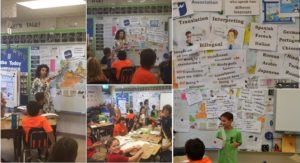In this sessions, I explore other topics in education I find exciting…
In the framework of AAIT 18, we discussed the level of awareness of T&I as a profession, I presented the idea that translators are mediators between clear communication and technology. ‘Artifical Intelligence’ is perhaps inadvertently omnipresent in our lives, from “intelligent’ vacuum cleaners to Tolstoi write-alikes. And then there is the push for clear communication heralded by the Plain Language movement. Plain Language seems to suggest language that is machine translatable. However, I advocate for Plain Language 2.0: clear communication with style. Yes, machines can do a great deal but infusing communication with relevant flair and without sacrificing clarity is still a human endeavor, that’s where sophisticated professionals come in.
Hélène Wimmerlin and I (Romina) advocate for teaching the non-translation side of translation, i.e., business, technology, and project management, as a key component in training professional translators. This presentation emerged amidst a debate about translators skills, and here we share cases from our own teaching and professional experience. We address relevant issues for the classroom situation and discuss how to integrate the needs and expectations of the different players—businesses, academic institutions, and students. During the live presentation, we served as moderators in an interactive and very passionate discussion with the audience!

T&I Outreach in a 4th Grade Classroom
What a blast it was to share this session with fourth graders from Gorrie Elementary School in Tampa, Florida–amidst preparations for a pretend 25‑year reunion!
I had the opportunity to prep before the children arrived, pinning to the board an upside-down map of the world, an ATA sign, and the words Languages, Translation and Interpreting.
The prompts sparked a rich conversation about different languages and perspectives. Although this class was mostly monoloingual, we quickly got into the difference between a native language and a second language, and talked about being bilingual.
This was the perfect springboard to talk about translation. As usual, the students mentioned speaking different languages, so I addressed the differences between Translation and Interpreting: translation is written and interpreting is spoken, and pinned images of a translator typing and an interpreter with a headset, as reminders. As a group, they came up with a definition of what they both do: help people who speak two different languages communicate.
Next, we discussed who translators and interpreters work for: hospitals, courts, the Olympics, videogame companies, book publishers, etc. I had images of Harry Potter in Italian and Dragon Ballz in Japanese to illustrate that you can work to or from a language. I also showed them books translated into English that they had read.
We also run a few “experiments.” First, we tried to translate words from French with visual aids. But the images prompted multiple words! They concluded that images are not enough.
Then, we tried a word-by-word translation from Spanish with the help of a glossary. It was horrible! They concluded studying the grammar of both languages is necessary.
After that, we run the same sentence through Google translate. It was much better, but still off. They worked as editors and adjusted the translation. They concluded that translation engines are not 100% accurate and that proper knowledge of your topic and audience is necessary.
Finally, we got to fun projects! We worked on a Gaturro comic strip (by Nik, from Argentina, with the author’s consent!). I provided a glossary and we also run the text through Google translate. Working as editors and with guidance, they came up with a correct an actually funny English version.
We also worked on a project as clients. We were US distributors of a “magic” toy that would teach kids about pneumatics created by a Spanish-speaking company. All materials for assembly and instructions with images were “delivered” to our classroom, full of eager toymakers. Of course, the instructions were in Spanish, and they knew that just following the images, using a glossary or running machine translation would not be accurate enough. They decided to hire a translator and sent the Spanish text out for translation. Once the translation was timely delivered, they reviewed it, duly asked for some clarifications, and paid for it with play bills! And on they went to assembling the pneumatic toys and even suggesting some upgrades!
For their “reunion,” some kids were considering returning as translators!
